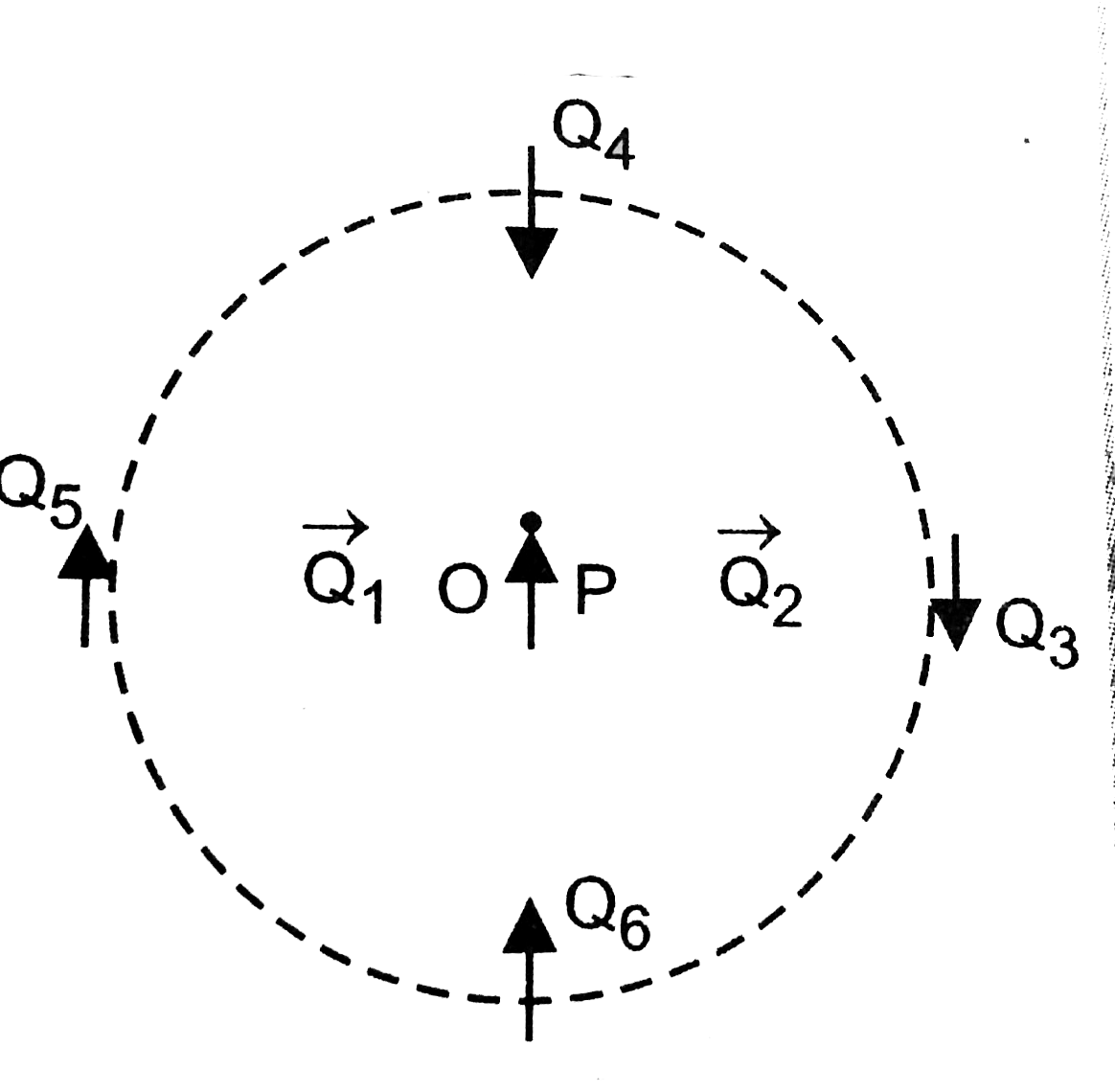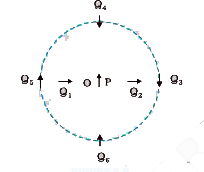The figure shows the various positions of small magnetised needles P and Q the arrows show the direction of their magnetic moment which lowest potentical energy among all the configuration shown
?  Solution in Kannada
Solution in Kannada
PQ3
PQ4
PQ5
PQ6
The correct Answer is:D
PQ6 corresponds to the lowest potential energy among all the configuration show
Topper's Solved these Questions
- MAGNETOSTATICSBOOK - MODERN PUBLICATIONCHAPTER - MAGNETOSTATICSEXERCISE - MULTIPLE CHOICE QUESTION (LEVEL I) (ASSERTION AND REASONING)
2 Videos
- MAGNETOSTATICSBOOK - MODERN PUBLICATIONCHAPTER - MAGNETOSTATICSEXERCISE - MULTIPLE CHOICE QUESTION (LEVEL I) (PARAGRAPH QUESTIONS )
1 Videos
- LAWS OF MOTIONBOOK - MODERN PUBLICATIONCHAPTER - LAWS OF MOTIONEXERCISE - Revision test
43 Videos
- MOCK TEST-1BOOK - MODERN PUBLICATIONCHAPTER - MOCK TEST-1EXERCISE - MCQs
47 Videos
Similar Questions
Statement 1: The poles of a magnet cannot be separted by breaking it into two pieces
Statement 2: The magnetic moment of a bar magnet will be reduced to half when a bar magnet is broken into two equal parts
View SolutionA magnet of pole strength m is divided into four equal parts so that the length and breadth of each part is half than that of the original magnet then pole strength of each is
View SolutionWhen a carpet is beaten with a stick, dust comes out of it. Explain.
View SolutionTwo capacitors of 4pF and 6pF are connected in series and a potential difference of 5 kV is applied across the combination. They are then disconnected and reconnected in paralle. The potential difference across combination is :
View SolutionFigure shows a small magnetized needle P placed at a point O. The arrow shows the direction of magnetic moment. The other arrows show different positions (and orientations of the magnetic moment) of another identical magnetized needle Q.

(a) In which configuration is the system not in equilibrium?
(b) In which configuration is the system in (i) stable and (ii) unstable equilibrium?
(c) Which configuration corresponds to the lowest potential energy among all the configurations shown?
View SolutionConsider the situation shown in the diagram, where A small magnetised needle A is placed at a centre marked, as O. The direction of its mangetic moment I s indicated by arrow. The other arrow show different position (and orientations of the magnetic moment) of antoher identical magnetised eedle X. In which configuration the system is not in equlibrium? (ii) In which configuration is the system in (a) stable and (b) unsable equilibrium (iii) Which configuration corresponds to the lowest potentials energy among all the configuration shown
View Solutionचित्र 5.5 में O बिंदु पर रखी गई एक छोटी चुंबकीय सुई P दिखाई गई है! तीर इसके चुंबकीय आघूर्ण की दिशा दर्शाता है! अन्य तीर, दूसरी समरूप चुंबकीय सुई Q की विभिन्न स्थितियों (एव चुंबकीय आघूर्ण के दिकविण्यासो) को प्रदर्शित करते है!
(a) किस विन्यास में यह निकाय संतुलन में नही होगा ?
(b) किस विन्यास में निकाय (i) स्थायी (ii) अस्थायी संतुलन में होंगे?
(c) दिखाए गए सभी विन्यासो में किस्मे न्यूनतम स्थितिज ऊर्जा है?

View Solutionघड़ी 7.30 बजे दिखा रही है । यदि मिनट की सुई पश्चिम दिशा को दिखा रही है, तो घण्टे की सुई किस दिशा को दिखा रही है, घंटे की सुई किस दिशा को दिखाएगी ?
View Solutionचित्र में बिंदु O पर रखी गई एक छोटी चुंबकीय सुई P दिखाई गई है। तीर इसके चुंबकीय आघूर्ण की दिशा दर्शाता है। अन्य तीर दूसरी समरूपचुंबकीय सुई Q की विभिन्न स्थितियों (एवं चुंबकीय आघूर्गों के दिक्विन्यासों) को प्रदर्शित करते हैं।
(a) किस विन्यास में यह निकाय संतुलन में नहीं होगा?
(b) किस विन्यास में निकाय (i) स्थायी, (ii) अस्थायी संतुलन में होंगे?
(c) दिए गए सभी विन्यासों में किसमें न्यूनतम स्थितिज ऊर्जा है?

View SolutionIn the given diagram, a small magnetised needle is placed at a point O. The arrow shows the direction of its magnetic moment. The other arrows shown different positions and orientations of the magnetic moment of another identical magnetic needs B. (a) In which configuration is the systems not in equilibrium?
View SolutionFigure shows a small magnetised needle P placed at a point O. The arrow shows the direction of magnetic moment. The other arrows show different positions (and orientations of the magnetic moment) of another identical magnetised needle Q.

(a) In which configuration is the system not in equilibrium?
(b) In which configuration is the system in (i) stable and (ii) unstable equilibrium?
(c) Which configuration corresponds to the lowest potential energy among all the configurations shown?
View SolutionFigure shows a small magnetised needle P placed at a point O. The arrow shows the direction of magnetic moment. The other arrows show different positions (and orientations of the magnetic moment) of another identical magnetised needle Q.

(a) In which configuration is the system not in equilibrium?
(b) In which configuration is the system in (i) stable and (ii) unstable equilibrium?
(c) Which configuration corresponds to the lowest potential energy among all the configurations shown?
View SolutionWhich configuration is widely used in circuits ?
View SolutionFigure 5.5 shows a small magnetised needle P placed at a point O. The arrow shows the direction of its magnetic moment. The other arrows show different positions (and orientations of the magnetic moment) of another identical magnetised needle Q.
(a) In which configuration the system is not in equilibrium?
(b) In which configuration is the system in (i) stable, and (ii) unstable equilibrium?
(c) Which configuration corresponds to the lowest potential energy among all the configurations shown?
View SolutionFigure 5.5 shows a small magnetised needle P placed at a point O. The arrow shows the direction of its magnetic moment. The other arrows show different positions (and orientations of the magnetic moment) of another identical magnetised needle Q.
(a) In which configuration the system is not in equilibrium?
(b) In which configuration is the system in (i) stable, and (ii) unstable equilibrium?
(c) Which configuration corresponds to the lowest potential energy among all the configurations shown?
View Solution
